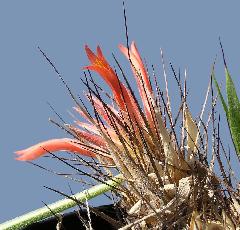
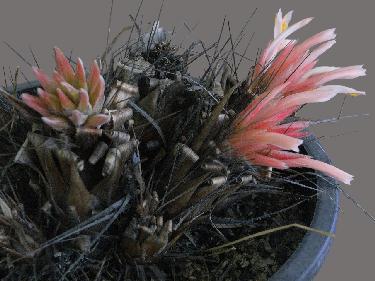
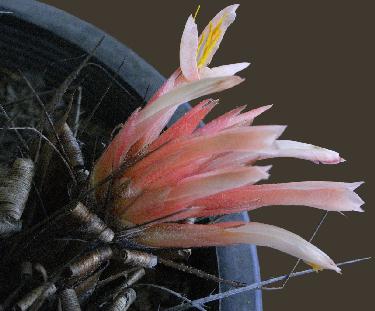
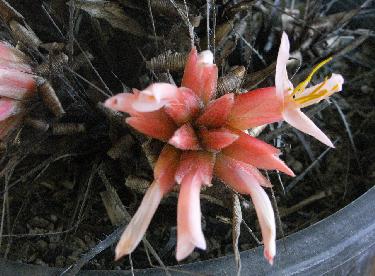
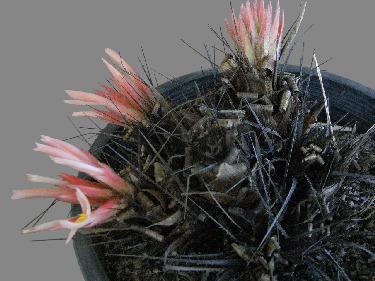
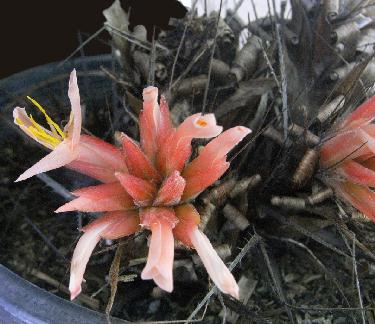
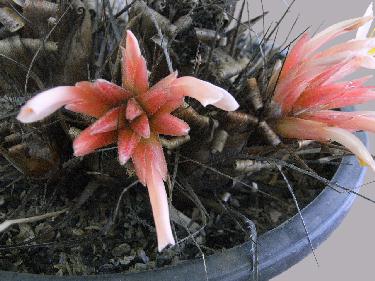
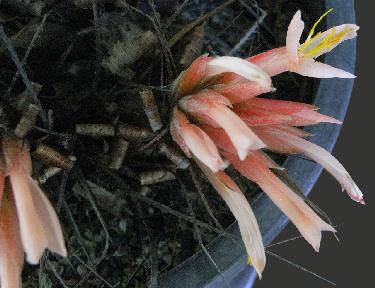
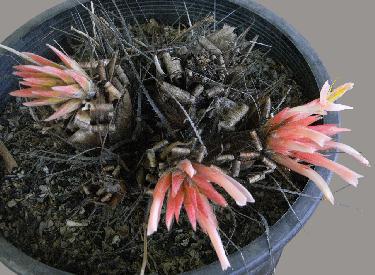
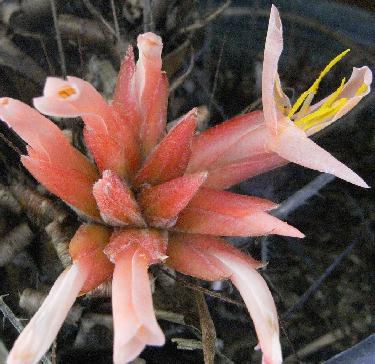
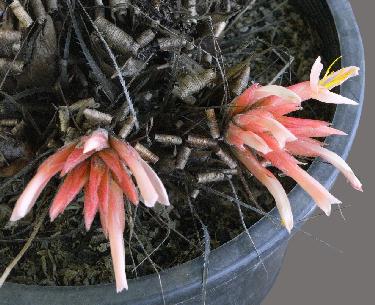
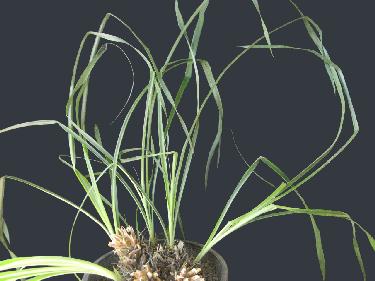
Reprinted from BSQ home page.
"GROWING PITCAIRNIAS AND PEPINIAS
(by Bob Reilly)
The Pitcairnia genus is named after a London doctor, Pitcairn. The genus can be found from southern Mexico and the West Indies down to northern Argentina and Peru. Most species are found in Brazil, Colombia and Peru. The only bromeliad species whose native habitat is outside of the Americas is a pitcarinia, namely, P. feliciana, which grows on cliff faces in tropical West Africa.
Many botanists argue the genus Pepinia should be included in the Pitcairnia genus. However, in this article the distinction has been maintained. There are over 250 species in there two genera.
Most pitcairnias and pepinias are grass-like plants that grow in the ground (terrestrials) or on rocks (lithophytes). A few are epiphytes. Most grow in moist, shady locations. Typically, they form a clump that develops through underground rhizomes.
The leaves of many pitcairnias and pepinias are spineless, while those plants with spines generally have small ones.
These plants’ leaves are quite variable in length and shape. Some have several types of leaves on the one plant. Perhaps the most graphic example of this variation can be found in “deciduous” species such as Pitcairnia heterophylla. In that species, the “normal” leaves drop off at the start of the dry season to help the plant conserve moisture. The short brown “spikes” that remain are a primitive type of leaf that contains no chloroypyll.
Pitcairnias and pepinias can be propagated easily either from seed or, for many species, by detaching a piece of the underground rhizome (taking care to obtain a piece with roots attached). The underground rhizome can be severed by either using a knife or, in some cases, a spade! Other pitcairnias and pepinias form bulbous-like growths that can be broken apart to provide new plants.
These plants will thrive if grown in a mixture similar to that used for most indoor plants. A mixture, which has given good results for myself, is comprised of 1 part Cocopeat or peatmoss to 1 part of coarse sand. A continuous release fertiliser, such as Osmocote, should be added to the potting mixture in the concentrations recommended by the manufacturer for indoor plants.
Re-pot the plants once a year. They typically like bigger pots for their size than other bromeliads. For example, a single offshoot of many species can often be grown into a small clump that requires a 250 mm bucket within 30 months.
Plants should be watered until water starts to flow through the pot’s base, at least three times a week in summer. Twice a week in winter should be adequate, except during periods of low humidity.
These plants’ leaves generally do not suffer from insect attacks, although grasshoppers can attack young leaves on rare occasions. However, aphids can cause significant damage to flowers.
Pitcairnias and pepinias will grow well under 50% shadecloth in winter and 75% for the rest of the year. They also thrive in shaded (but well drained for virtually all species) areas in the garden, but are unlikely to do well in situations that receive the full afternoon sun (especially in summer).
When grown in the ground, pitcairnias relatively tall (usually 50cm or more) green, grass-like foliage can form an effective “backdrop” to a planting, in front of them, comprised of their more colourful bromeliad brethren, for example, neoregelias.
The ancestors of many of the plants currently grown in Australia were obtained by growing plants from seed obtained from overseas. While many interesting plants were obtained, unfortunately it has become obvious that quite a few are incorrectly identified.
While there are few named pitcairnia and pepinias hybrids, it is possible many of the “species” grown in Australia could be hybrids. Alternatively, some species are much more variable in appearance than is commonly believed.
Pitcairnias and pepinias are not readily available. However, you should be able to build up a collection of 10 or more species, over a period of several years, by searching for them at the Society’s field days, monthly meetings and shows, and asking bromeliad nurseries. If you are willing to settle for a rhizome with a few leaves and roots attached, rather than a well-established plant in a pot, then you are in the best position to quickly build up your collection.
Eighteen species are described below. However, it is likely there are at least 30 species and hybrids cultivated in Australia.
Pepinia sanguinea The plant’s arching leaves are up to 60 cm long and 6 cm across at their widest point. The leaves are a “velvet green”, flushed with maroon, on their upper surfaces, and maroon underneath. This plant is well worth growing. Several hybrids have been made with it as one of their parents.
Pitcairnia andreana This is one of the smallest plants in the genus. The light green leaves are 30 to 40 cm long and up to 4 cm wide. The inflorescence rises above the leaves on a stalk that is about 15 cm long. A cluster of around 10 flowers, each of which is about 10 cm long, constitute the inflorescence. The flowers’ petals are orange at their base, and yellow for their remaining length.
Pitcairnia burle-marxii This plant has a “caulescent” growth habit, that is, it has a distinct stem. The semi-succulent leaves are 3 cm wide and 15 cm long, olive-green on top and maroon in colour underneath. It has a “simple”, that is unbranched, spike of about 15 flowers.
Pitcairnia atrorubens The arching, green leaves are up to 100 cm long and 5 cm wide at their widest point. The dark red, cylindrical spike, which is 40 to 60 cm long, arises from a 30 to 50 cm long stalk. The 3 cm long flowers have yellow or red petals.
Pitcairnia carinata The dark green leaves are about 60 cm long and up to 3 cm wide. The raceme (an elongated cluster of stalked flowers) is bright red, and 20 to 30 cm long. The flowers have red petals.
Pitcairnia flammea v. roezlii The arching leaves are 60 to 80 cm long, and 3 cm wide at their widest point. Each leaf’s upper surface is dark green, while the underside is covered with a dense, silvery-grey “scurf”. The cylindrical infloresence is about 40 cm long, and 5 cm wide. The top of the infloresence is about 60 cm above the tips of the plant’s leaves.
Pitcairnia funkiae The arching green leaves are up to 100cm long and 8cm across at their widest point. A 20 cm long, cylindrical, brown inflorescence does not reach the top of the plants’ leaves.
Pitcairnia grafii The light green leaves are 30 cm long, 3 cm wide, and form a semi-erect rosette about 50 cm across. The infloresence rises well above the plant’s leaves, and consists of a red-orange pyramidal spike about 30 cm tall. Its flowers have yellow petals.
Pitcairnia heterophylla This deciduous plant has 60 cm long light green leaves. At the start of autumn, these leaves are shed and the plant consists of a small clump of brown, spiny “leaves”. In spring, a cluster of flowers with pink to red or white petals appears at the end of a short stalk. As the plant is basically dormant in winter, be careful not to over-water it.
Pitcairnia imbricata The light green leaves are up to 60 cm long and 5 cm wide. The inflorescence is a light-red cylindrical spike about 50 cm long. The flowers are about 5 cm long, while the petals are creamy-yellow.
Pitcairnia integrifolia Leaves are 60 to 80 cm long and up to 3 cm wide. The leaves’ upper surface is a dull green, with the under surface being covered with dense, grey scales. The branched inflorescence is about 50 cm long and 30 cm wide. The flowers are about 3 cm long, and have petals that are yellow at their base and bright red at their tips.
Pitcairnia maidifolia It has two types of leaves. The inner, green leaves are about 10 cm wide, 30 cm long, and occur at the end of long stalks, while the outer leaves are reduced to blackish “sheaths”. Its yellow-green flower spike consists of a 20 cm long elongated cluster of flowers, located on top of a 30 to 60 cm long stalk. The flowers have white petals.
Pitcairnia nigra The plant is about 80 cm tall, with leaves up to 15 cm wide. A cylindrical spike, which is 10 to 50 cm long and 5 to 7 cm wide, arises from a 20 cm long stalk. The flowers have 10 cm long petals that are yellowish-white at their base, and are black-purple at their tips.
Pitcairnia riparia Individual plants occur on the ends of numerous, above-ground, branching, rhizome-like growths. Each plant consists of a semi-erect “tight” cluster of 5 to 10 leaves. Each of the light green leaves is about 40 cm long and 1 cm wide. The pendent infloresence consists of a spike having around 10 red-petalled flowers. This plant can be grown in a hanging basket.
Pitcairnia smithiorum The species was botanically described only in 1991, and is one of the most spectacular pitcairnias. The arching, light green leaves are up to 80 cm long and 5 cm wide. An egg-shaped, reddish spike, which is about 10 cm long and 7 cm wide, arises from a 30 to 50 cm long stalk. The spike is level with the top of the plant’s leaves. The flowers have orange-yellow petals. Several beautiful hybrids have been made using this plant.
Pitcairnia tabuliformis This plant has a very different appearance to the other piticairnias described in this article. About 20 green leaves, 15 cm long and 7 cm wide, form a flattened (table-like) rosette. About 40 flowers form a 5 to 7 cm wide, “head-shaped” cluster in the plant’s centre. The flowers’ petals are orange-red. This is a rare plant.
Pitcairnia undulata Its leaves are 15 to 20 cm wide, 70 cm long, pale green on top, and whitish-green on their lower surface. The red infloresence is about 30 to 45 cm long, and consists of an elongated cluster of flowers that have red petals.
Pitcairnia xanthocalyx This plant readily forms a large clump. The 100 cm long leaves are up to 2.5 cm in width. The leaves’ upper surface is light green, while the lower surface is light grey. The many-flowered raceme, which is 50 to 70 cm long, arises from a 60 cm long stalk. The 2 to 5 cm long petals are yellow.
If you only have space for a few pitcairnias, I suggest you try atrorubens, heterophylla, nigra, and smithiorum. Colour photographs of over 50 pitcairnias, including many discussed in this article, appear in Bromeliads by Francisco Oliva-Esteve. This book can be borrowed from the Society’s library. Colour photographs of pitcairnias, including the P. smithiorum hybrids mentioned previously, can also be seen on the Florida Council of Bromeliad Societies’ website: www.fcbs.org
The best Pepinia to grow is P. sanguinea.
I thank Mike Symmons for his help in preparing this article, and Doug Upton for taking the photographs used to illustrate it.
Author Contact details: email: threereillys@bigpond.com.au , phone (07) 3870 8029"